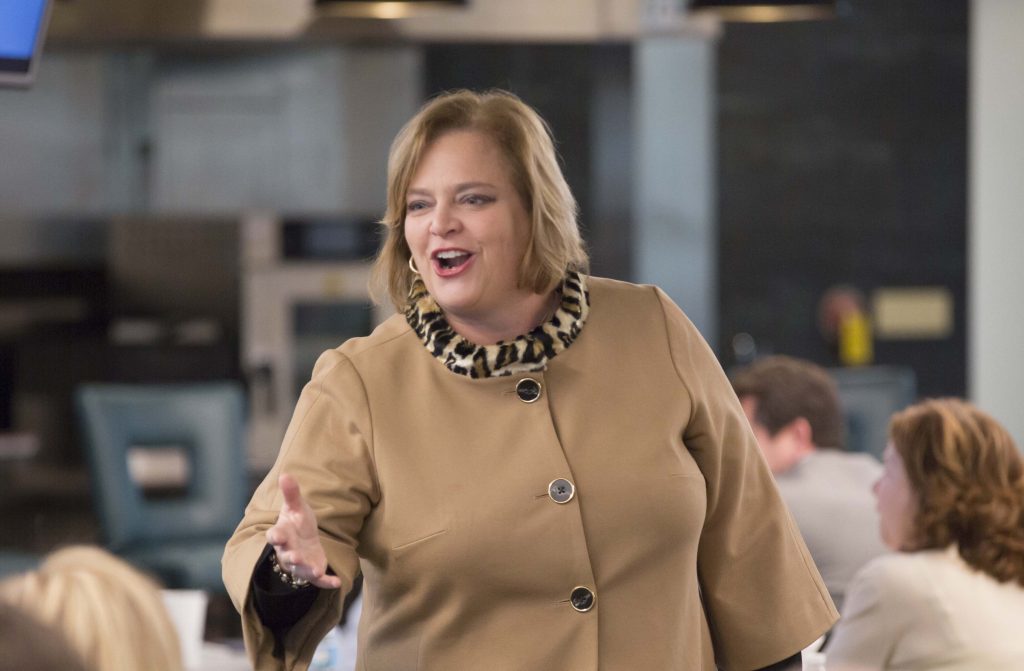For years, the senior housing industry has looked up to Chick-fil-A for a variety of reasons—from its discounting approach to its ability to attract and keep frontline staff.
One senior living CEO—Richard Brewer of Commonwealth Senior Living—even encouraged his son to get a job at Chick-fil-A, to learn more about the company’s secret sauce. While this gave Brewer a unique window in, there are easier ways for senior living to learn from the quick-service restaurant chain. Recently, the company’s Vice President of Enterprise Social Responsibility Dee Ann Turner opened up about its approach at Dished, an event hosted March 1 in Chicago by Senior Housing News.
Senior living dining was the focus of Dished, but Turner focused less on how Chick-fil-A makes its food and more on the ingredients of its renowned company culture.
The Atlanta, Georgia-based enterprise reports a franchisee retention rate of 95%, and its franchisees “enjoy one of the lowest turnover rates in the industry,” according to Turner.
The company believes that there’s a very specific reason for this, Turner said.
“We attribute [our retention rate] to knowing our ‘why,’” she explained. In other words, all Chick-fil-A employees believe in the company’s mission, and that contributes to their willingness to work in the Chick-fil-A environment, day after day.
All the while, corporate representatives know what to look for when they visit franchise locations to get an accurate sense of the restaurant’s quality, and, as is the case at many senior housing providers, everyone at Chick-fil-A knows that they’re not above any job—including cleaning up trash on the side of the road.
Define the ‘why’
Despite its impressive retention rates, Chick-fil-A isn’t immune to turnover, especially at the restaurant level. It’s a situation that senior living providers are all too familiar with, as tight labor markets are worsening a caregiver crunch and high turnover rates.
“I see this war for talent that we’re in right now,” Turner said.
Like many hourly senior housing employees working in communities’ dining rooms and bistros—as well as in other departments—the hourly workforce at Chick-fil-A restaurants is made up of relatively young people.
“Our hourly workers are 16, 17, 18, predominantly,” Turner explained. Due to their age, hourly Chick-fil-A workers aren’t necessarily looking to work for Chick-fil-A franchisees long-term. However, the reason the company is in business, “to be a faithful steward of all that is entrusted to [it],” has helped it retain workers of all ages, executives believe.
Additionally, this motto—“to be a faithful steward of all that is entrusted to us”—is corporate Chick-fil-A’s “why.” As in, why everyone comes to work each day. Each franchisee gets to choose their own “why,” Turner noted.
Inevitably, Chick-fil-A restaurants won’t always succeed in impressing customers.
“We’re not perfect, sometimes we make mistakes,” Turner admitted.
It’s important for companies—food service or otherwise—to be able to hit a virtual “reset” button if they hit any sort of bump in the road. And being able to do that gets back to having a clear and powerful “why.”
“We really have some big challenges,” she said. “Every time that happens, this is what we do: We go back to, why are we here at all?”
Taste the coleslaw, clean up the exit ramp
Of course, Chick-fil-A doesn’t only want to score high marks with its workers—it wants to score high marks with its customers as well. Here, too, the company appears to be outdoing the competition. In a recently released Harris Poll ranking the reputations of the country’s most well-known companies, Chick-fil-A came in at No. 4 overall. It was the only restaurant chain in the top 50.
Turner described some strategies for ensuring consistent, high-quality service is being delivered, even by its young workforce. When senior living executives are visiting a community, they might want to ask themselves if they are “tasting the coleslaw.”
For a while, Chick-fil-A sold coleslaw at all of its restaurants, which had to be made “just right” and yet it was a complicated dish to execute, according to Turner. The cabbage had to chopped in a specific way, there had to be just enough carrots. So, when representatives from Chick-fil-A corporate would visit different franchise locations, they’d always ask to taste the coleslaw.
“If the coleslaw was right, everything else was probably right, too,” Turner explained.
Chick-fil-A also has a commitment to make an exceptional impression on anyone encountering the brand, whether in a restaurant or not.
Former Chick-fil-A President and COO Jimmy Collins, for instance, used to clean up trash on the side of the exit ramp two miles away from the corporate office, even though it was technically the responsibility of the local municipality. He wanted to enhance the experience of visitors to the headquarters building.
Also, Collins’ willingness to do a job that was thought to be “below him” caught on, and now other people who work at the Chick-fil-A corporate headquarters similarly pull over when they see trash a few miles away. After all, they don’t want visitors or even people who drive by to have anything but nice thoughts about the company.
Ultimately, senior living providers and Chick-fil-A would seem to share the same goal:
“Chick-fil-A wants to create remarkable experiences,” Turner said.
Written by Mary Kate Nelson


